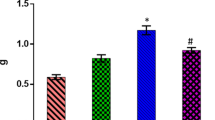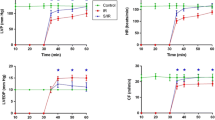Abstract
This study was designed to assess the effects of saffron (Crocus sativus) on rats’ heart with isoproterenol-induced myocardial injury. Animals were divided randomly into four groups: vehicle-control group (CTL); ISO group, administrated with Isoproterenol 85 mg/kg s.c.; saffron group; and finally combined Saffron + ISO group. Basal and final serum levels of heart troponin I, heart tissue antioxidants and histopathological indices were assessed in all groups. Isoproterenol administration significantly increased serum level of troponin I when compared to control group (3.46 ± 0.77 vs. 0.53 ± 0.35 ml in ng/ml, P < 0.001) and reduced significantly the glutathione peroxidase activity of heart muscle (1.63 ± 0.21 vs. 4.01 ± 0.64 nmol/mg protein, P < 0.05). The grade of heart muscle damages was severe in more than 70% of ISO group animals. Saffron + ISO group showed remarkably decreased intensity of tissue destruction and significantly decreased serum levels of heart troponin I, when compared to ISO group (1.25 ± 0.23 vs. 3.46 ± 0.77 ng/ml, P < 0.05). The level of glutathione peroxidase activity in Saffron + ISO animals did not have significant decline compared to saffron alone. These results suggest the protective role of saffron on ischemic hearts by biochemical and histopathological findings.





Similar content being viewed by others

References
Market Sector Assessments SME Development available from: http://www.undp.org.af/Publications/KeyDocuments/Final_Report_MSA_SME_Altai_Cons_July_14th_2005.pdf Accessed June 28, 2009.
Rios, J. L., Recio, M. C., Ginger, R. M., & Manz, S. (1996). An update review of saffron and its active constituents. Phytotherapy Research, 10, 189–193.
Hosseinzadeh, H., & Younesi, H. M. (2002). Antinociceptive and anti-inflammatory effects of Crocus sativus L. stigma and petal extracts in mice. BMC Pharmacology, 2, 7.
Abdullaev, F. I., & Espinosa-Aguirre, J. J. (2004). Biomedical properties of saffron and its potential use in cancer therapy and chemoprevention trials. Cancer Detection and Prevention, 28, 426–432.
Pitsikas, N., & Sakellaridis, N. (2006). Crocus sativus L. extracts antagonize memory impairments in different behavioural tasks in the rat. Behavioural Brain Research, 173, 112–115.
Fatehi, M., Rashidabady, T., & Fatehi-Hassanabad, Z. (2003). Effects of Crocus sativus petals’ extract on rat blood pressure and on responses induced by electrical field stimulation in the rat isolated vas deferens and guinea-pig ileum. Journal of Ethnopharmacology, 84, 199–203.
Boskabady, M. H., Shafei, M. N., Shakiba, A., & Sang Sefidi, H. (2008). Effect of aqueous-ethanol extract from Crocus sativus (Saffron) on Guinea-pig isolated heart. Phytotherapy Research, 22, 330–334.
Hosseinzadeh, H., Sadeghnia, H. R., Ziaee, T., & Danaee, A. (2005). Protective effect of aqueous saffron extract (Crocus sativus L.) and crocin, its active constituent, on renal ischemia-reperfusion-induced oxidative damage in rats. Journal of Pharmacology and Pharmaceutical Science, 8, 387–393.
Ochiai, T., Shimeno, H., Mishima, K., Iwasaki, K., Fujiwara, M., Tanaka, H., et al. (2007). Protective effects of carotenoids from saffron on neuronal injury in vitro and in vivo. Biochimica et Biophysica Acta, 1770, 578–584.
Zheng, Y. Q., Liu, J. X., Wang, J. N., & Xu, L. (2007). Effects of crocin on reperfusion-induced oxidative/nitrative injury to cerebral microvessels after global cerebral ischemia. Brain Research, 1138, 86–94.
Karthikeyan, K., Sarala Bai, B. R., & Niranjali Devaraj, S. (2007). Cardioprotective effect of grape seed proanthocyanidins on isoproterenol-induced myocardial injury in rats. International Journal of Cardiology, 115, 326–333.
Saleem, S., Ahmad, M., Ahmad, A. S., Yousuf, S., Ansari, M. A., Khan, M. B., et al. (2006). Effect of Saffron (Crocus sativus) on neurobehavioral and neurochemical changes in cerebral ischemia in rats. Journal of Medicinal Food, 9, 246–253.
Premkumar, K., Abraham, S. K., Santhiya, S. T., & Ramesh, A. (2003). Inhibitory effects of aqueous crude extract of Saffron (Crocus sativus L.) on chemical-induced genotoxicity in mice. Asia Pacific Journal of Clinical Nutrition, 12, 474–476.
Salomi, M. J., Nair, S. C., & Panikkar, K. R. (1991). Inhibitory effects of Nigella sativa and saffron (Crocus sativus) on chemical carcinogenesis in mice. Nutrition and Cancer, 16, 67–72.
Lowry, O. H., Rosebrough, N. J., Farr, A. L., & Randall, R. J. (1951). Protein estimation with the folin-phenol reagent. The Journal of Biological Chemistry, 193, 265–275.
Ohkawa, H., Ohishi, N., & Yagi, K. (1979). Assay of lipid peroxidation in animal tissues by thiobarbituric acid reaction. Analytical Biochemistry, 95, 351–358.
Paglia, D. E., & Valentine, W. N. (1967). Studies on the quantitative and qualitative characterization of erythrocyte glutathione peroxidase. Journal of Laboratory and Clinical Medicine, 70, 158–169.
Rona, G., Chappel, C. I., Balazs, T., & Gaudry, R. (1959). An infarct-like myocardial lesion and other toxic manifestations produced by isoproterenol in the rat. AMA Archives of Pathology, 67, 443–455.
York, M., Scudamore, C., Brady, S., Chen, C., Wilson, S., Curtis, M., et al. (2007). Characterization of troponin responses in isoproterenol-induced cardiac injury in the Hanover Wistar rat. Toxicologic Pathology, 35, 606–617.
Sharma, M., Kishore, K., Gupta, S. K., Joshi, S., & Arya, D. S. (2001). Cardioprotective potential of ocimum sanctum in isoproterenol induced myocardial infarction in rats. Molecular and Cellular Biochemistry, 225, 75–83.
Singal, P. K., Kapur, N., Dhillon, K. S., Beamish, R. E., & Dhalla, N. S. (1982). Role of free radicals in catecholamine-induced cardiomyopathy. Canadian Journal of Physiology and Pharmacology, 60, 1390–1397.
Saravanan, G., & Prakash, J. (2004). Effect of garlic (Allium sativam) on lipid peroxidation in experimental myocardial infarction in rats. Journal of Ethnopharmacology, 94, 155–158.
Anandan, R., Deepa Rekha, R., & Devaki, T. (1999). Protective effect of Picrorhiza kurroa on mitochondrial glutathione antioxidant system in d-galactosamine induced hepatitis in rats. Current Science, 76, 1543–1546.
Bloom, S., & Davis, D. (1972). Calcium as mediator of isoproterenol induced myocardial necrosis. American Journal of Pathology, 69, 459–470.
Acknowledgments
The authors are thankful to Ms. S. Saeb and Ms. Z. Razmi of clinical biochemistry MSc students, for collaborating in biochemical tests’ performance and the Vice Chancellor of Research, Kerman University of Medical Sciences for financial support.
Author information
Authors and Affiliations
Corresponding author
Rights and permissions
About this article
Cite this article
Joukar, S., Najafipour, H., Khaksari, M. et al. The Effect of Saffron Consumption on Biochemical and Histopathological Heart Indices of Rats with Myocardial Infarction. Cardiovasc Toxicol 10, 66–71 (2010). https://doi.org/10.1007/s12012-010-9063-1
Published:
Issue Date:
DOI: https://doi.org/10.1007/s12012-010-9063-1



